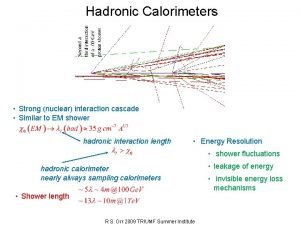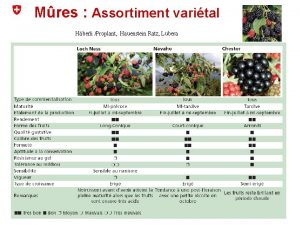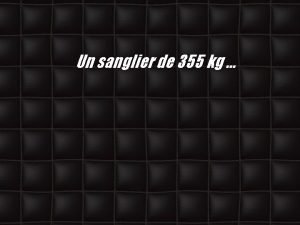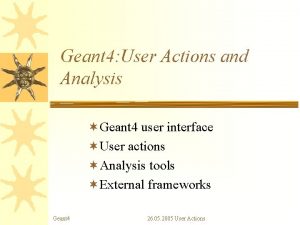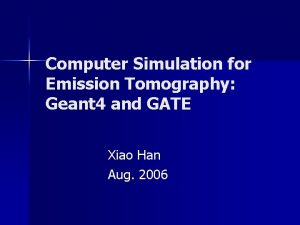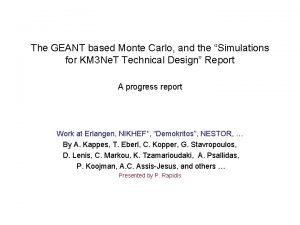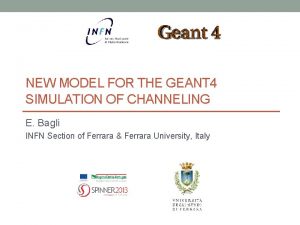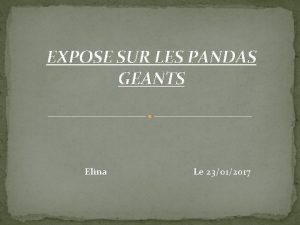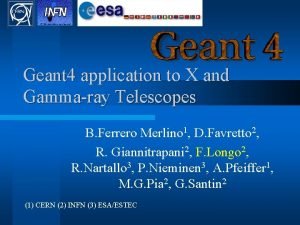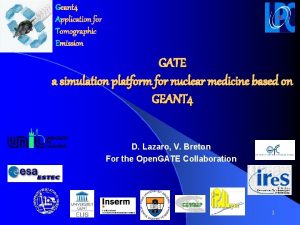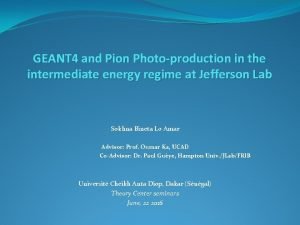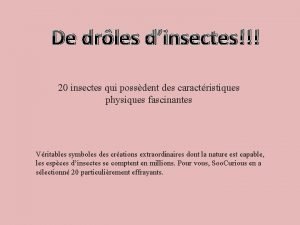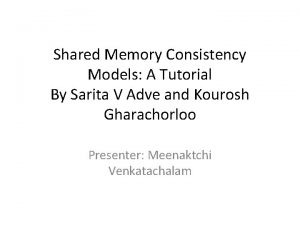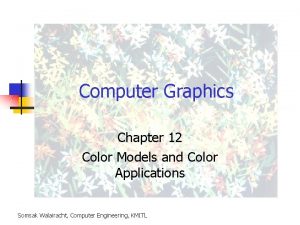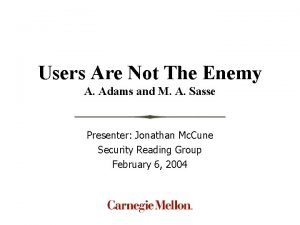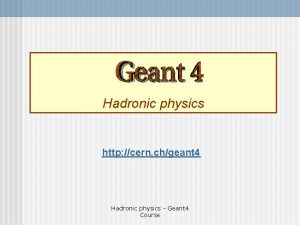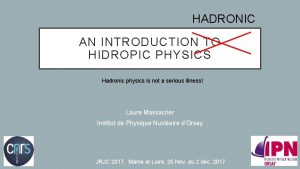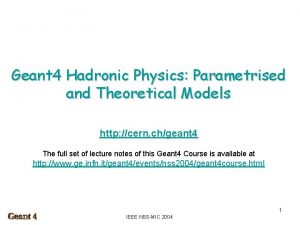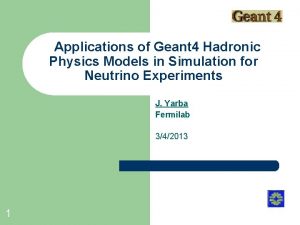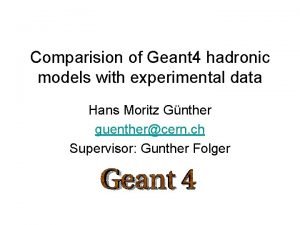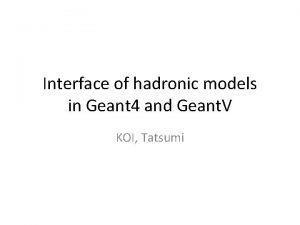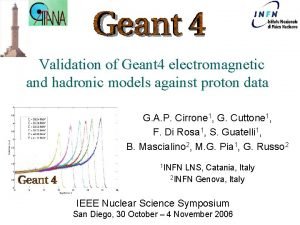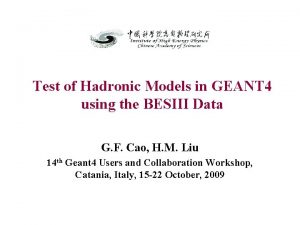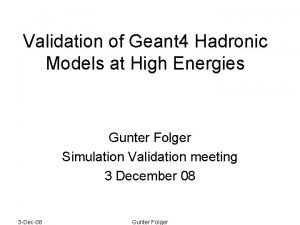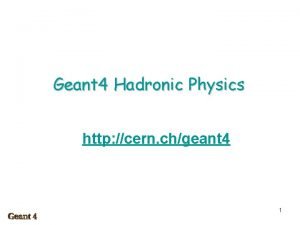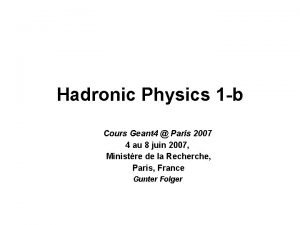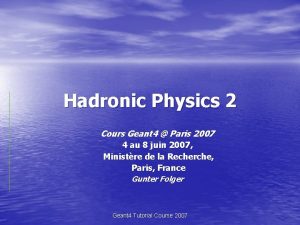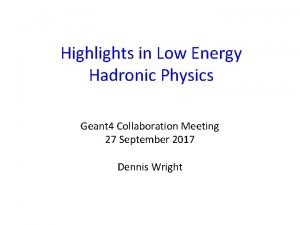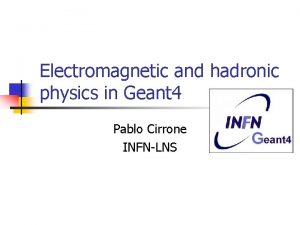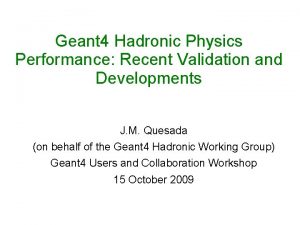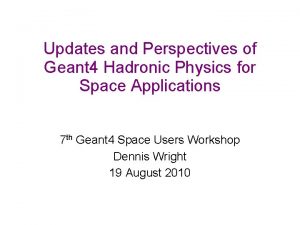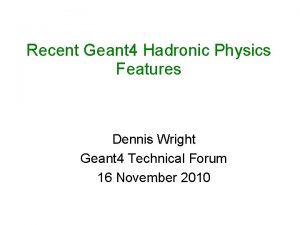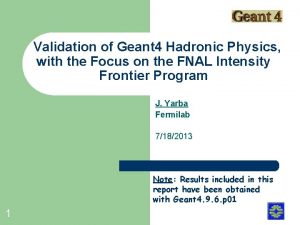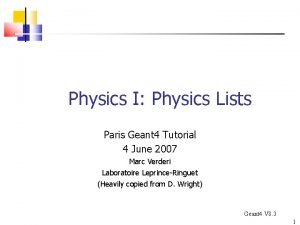Hadronic Physics Models Geant 4 Users Tutorial at


























- Slides: 26

Hadronic Physics Models Geant 4 Users' Tutorial at CERN 25 -27 May 2005 Dennis Wright (SLAC)

Outline ● Parameterized models – high energy – low energy ● Bertini cascade model ● High precision neutron models ● Photo- and electro-nuclear models ● Isotope production

Parameterized Models ● Two models available: – Low Energy Parameterized (LEP) for < 20 Ge. V – High Energy Parameterized (HEP) for > 20 Ge. V – LEP and HEP each refer to a collection of models, one for each particle type ● Both derived from GHEISHA model used in Geant 3 ● Core code: – hadron fragmentation – cluster formation and fragmentation – nuclear de-excitation

LEP, HEP (Comic Book Version) CM Frame

LEP, HEP models (text version) ● Modeling sequence: – initial interaction of hadron with nucleon in nucleus – highly excited hadron is fragmented into more hadrons – particles from initial interaction divided into forward and backward clusters in CM – another cluster of backward going nucleons added to account for intra-nuclear cascade – clusters are decayed into pions and nucleons – remnant nucleus is de-excited by emission of p, n, d, t, alpha

Using the LEP and HEP models ● ● The LEP and HEP models are valid for p, n, p, K, L, S, X, W, a, t, d – LEP valid for incident energies of 0 – ~30 Ge. V – HEP valid for incident energies of ~10 Ge. V – 15 Te. V Invocation sequence – G 4 Proton. Inelastic. Process* pproc = new G 4 Proton. Inelastic. Process(); G 4 LEProton. Inelastic* LEproton = new G 4 LEProton. Inelastic(); pproc -> Register. Me(LEproton); G 4 HEProton. Inelastic* HEproton = new G 4 HEProton. Inelastic(); HEproton -> Set. Min. Energy(20*Ge. V); pproc -> Register. Me(HEproton); proton_manager -> Add. Discrete. Process(pproc);

Validation of LEP, HEP Models

Bertini Cascade Model ● ● The Bertini model is a classical cascade: – it is a solution to the Boltzman equation on average – no scattering matrix calculated – can be traced back to some of the earliest codes (1960 s) Core code: – elementary particle collider: uses free-space cross sections to generate secondaries – cascade in nuclear medium – pre-equilibrium and equilibrium decay of residual nucleus – detailed 3 -D model of nucleus

Bertini Cascade (Comic Book Version)

Bertini Cascade (text version) ● Modeling sequence: – incident particle penetrates nucleus, is propagated in a density-dependent nuclear potential – all hadron-nucleon interactions based on free-space cross sections, angular distributions, but no interaction if Pauli exclusion not obeyed – each secondary from initial interaction is propagated in nuclear potential until it interacts or leaves nucleus – during the cascade, particle-hole exciton states are collected – pre-equilibrium decay occurs using exciton states – next, nuclear breakup, evaporation, or fission models

Using the Bertini Cascade ● ● In Geant 4 the Bertini model is currently used for p, n and p – valid for incident energies of 0 – 10 Ge. V – may be extended to 15 Ge. V when new validation data are available – currently being extended to kaons and hyperons Invocation sequence – G 4 Cascade. Interface* bertini = new G 4 Cascade. Interface(); G 4 Proton. Inelastic. Process* pproc = new G 4 Proton. Inelastic. Process(); pproc -> Register. Me(bertini); proton_manager -> Add. Discrete. Process(pproc);

Validation of the Bertini Cascade

High Precision Neutron Model ● ● ● Data-driven model – little theoretical input – cross sections, angular distributions, fission yields, photon emission probabilities, etc. taken from evaluated neutron data libraries Intended for low energy neutrons ( < 20 Me. V) – OK for thermal neutrons as well – elastic, inelastic scattering, neutron-induced fission and radiative capture models available Core code: – G 4 NDL neutron data library – interpolaters

HP Neutrons (Comic Book Version) elastic inelastic a n n n rad. capture fission g A A+1 n n

High Precision Neutron Model ● Modeling: – elastic scattering: get final state by looking up differential cross section or Legendre coefficients to get angular distributions – radiative capture: look up photon multiplicities or production cross sections, then sample from discrete and continuous energy spectra, and tabulated angular distributions – inelastic scattering: use cross section data to choose from among 35 final states of up to four particles – fission: use tabulated neutron yields and angular distribution parameters, several options for generating final state neutrons and fission fragments

Using the HP Neutron Model ● ● First set environment variable to point to data library: – setenv Neutron. HPCross. Sections somedir/G 4 NDL 3. 7 – G 4 NDL 3. 7 must first be downloaded from Geant 4 distribution page into your directory Invocation sequence – G 4 Hadron. Elastic. Process* nelproc = new G 4 Hadron. Elastic. Process(); G 4 Neutron. HPElastic. Data* neldata = new G 4 Neutron. HPElastic. Data(); G 4 Neutron. HPElastic* nelmodel = new G 4 Neutron. HPElastic(); nelproc -> Register. Me(nelmodel); nelproc -> Add. Data. Set(neldata); neutron_manager -> Add. Discrete. Process(nelproc); – repeat for inelastic neutron scattering, neutron-induced fission and radiative neutron capture

Validation of the HP Neutron Model

Isotope Production Models ● ● Default model – isotope produced = residual nucleus of any reaction – produced isotope is tracked Neutron-induced production: – G 4 Neutron. Isotope. Production – valid for En < 100 Me. V – requires G 4 NDL and Neutron. HPCross. Sections env. var. to be set – uses G 4 Track object to get surrounding material, then nucleus, then production cross sections

Using the Isotope Production Models ● ● Default production model: – Disable: process -> Disable. Isotope. Production. Globally(); – Enable: process -> Enable. Isotope. Production. Globally(); Neutron-induced production model: – setenv Neutron. HPCross. Sections somedir/G 4 NDL 3. 7 – G 4 Hadron. Inelastic. Process* inelproc = new G 4 Hadron. Inelastic. Process(); G 4 Neutron. Isotope. Production* isomodel = new G 4 Neutron. Isotope. Production(); inelproc -> Regsister. Isotope. Production. Model(isomodel);

Electro- and Photo-nuclear Models ● ● ● Hybrid models: both electromagnetic and hadronic – use parameterization of measured photon cross sections – several theoretical models (one EM, two hadronic) Core code: – CHIPS (Chiral Invariant Phase Space) model – quark-gluon string model – method of equivalent photons (for incident e+/e-) Valid for e- , e+ , g all energies up to 100 Te. V – CHIPS below 3. 5 Ge. V – quark-gluon string model above 3 Ge. V (VDM)

Electro-nuclear model (below 3 Ge. V) (Comic Book Version) *

Electro-nuclear model (text version) ● Modeling sequence: – virtual photon from e+/e- converted to real photon by method of equivalent photons – real photon cross section determines interaction rate – below 3. 5 Ge. V: – real photon interacts inside nuclear matter, creates quasmon (generalized hadron in CHIPS model) ● quasmon decays by quark fusion above 3 Ge. V, photon treated as a hadron: ● ● ● quark-gluon string formed and decayed residual nucleus is de-excited

Using the Electro- and Photo-Nuclear Models ● Electro-nuclear model (for e+, e- only): – ● G 4 Electron. Nuclear. Process* enproc = new G 4 Electron. Nuclear. Process(); G 4 Electro. Nuclear. Reaction* en. Model = new G 4 Electro. Nuclear. Reaction(); enproc -> Register. Me(en. Model); electron_manager -> Add. Discrete. Process(enproc); Photo-nuclear model (g): – G 4 Photo. Nuclear. Process* gnproc = new G 4 Photo. Nuclear. Process(); G 4 Gamma. Nuclear. Reaction* gnmodel = new G 4 Gamma. Nuclear. Reaction(); gnmodel -> Set. Max. Energy(3. 5*Ge. V); gnproc -> Register. Me(gnmodel); gamma_manager -> Add. Discrete. Process(gnproc);

Validation of the Photo-nuclear/CHIPS Model

Summary/Recommendations (1) ● ● LEP/HEP are the simplest and most versatile – all energies, all (long-lived) hadrons – use if no other model available – also the fastest – good for general purpose simulation where hadronic physics is not the main focus Bertini cascade is better for p, n, p – ~ 8 X slower than LEP – only valid below 10 Ge. V – alternative is Binary cascade – useful for calorimetry and medium energy experiments

Summary/Recommendations (2) ● ● ● High precision neutron models are the most accurate – but only for neutrons below 20 Me. V – good for studying accelerator background, shielding, dosimetry, medical etc. Electro- and gamma-nuclear models – hybrid hadronic/EM – only model for hadronic interaction of e+, e-, g below 3. 5 Ge. V Isotope production – useful for shielding, space radiation, space electronics, medical studies
 Hadronic
Hadronic Hadronic shower
Hadronic shower Myrtillier géant
Myrtillier géant Renmap
Renmap Sanglier poids record
Sanglier poids record Engin le plus gros du monde
Engin le plus gros du monde Action geant
Action geant Geant computer
Geant computer Geant simulation
Geant simulation Geant 4
Geant 4 Le géant atlas dans son café de bonsecours
Le géant atlas dans son café de bonsecours Exposé sur le panda géant
Exposé sur le panda géant Geant 4
Geant 4 Geant 4
Geant 4 Pub geant
Pub geant Gate geant
Gate geant Pion geant
Pion geant Blatte rhinocéros
Blatte rhinocéros Modals and semimodals
Modals and semimodals Distributed shared memory architecture tutorialspoint
Distributed shared memory architecture tutorialspoint Colour models in computer graphics
Colour models in computer graphics Why does it happen
Why does it happen University physics with modern physics fifteenth edition
University physics with modern physics fifteenth edition Ib physics ia examples
Ib physics ia examples External users of accounting information
External users of accounting information Web accessibility for older users
Web accessibility for older users Yahoomail7
Yahoomail7

